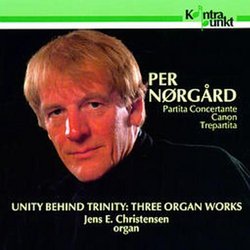| All Artists: Jens E. Christensen Title: Unity Behind Trinity: Three Organ Works Members Wishing: 0 Total Copies: 0 Label: Kontrapunkt Original Release Date: 1/1/2005 Re-Release Date: 1/1/2010 Album Type: Import Genre: Classical Styles: Forms & Genres, Suites Number of Discs: 1 SwapaCD Credits: 1 UPC: 716043208128 |
Search - Jens E. Christensen :: Unity Behind Trinity: Three Organ Works
 | Jens E. Christensen Unity Behind Trinity: Three Organ Works Genre: Classical
|
Larger Image |
CD Details |
CD ReviewsThree very different organ works from a composer who has con Christopher Culver | 12/12/2008 (3 out of 5 stars) "Each of the three solo organ works that Per Norgard wrote between the 1950s and 1990 capture the concerns of a different stylistic period, though they all share Norgard's perennial interest in "interference" between ambiguous musical lines. In the late 1980s, he wrote a new piece for organist Jens E. Christensen, and then supervised this 1991 Kontrapunkt recording where Christensen performs the hitherto extant works for the instrument.
When Norgard wrote the "Partita Concertante" op. 23 (1958), he was working within a Nordic aestethic inspired first by his teacher Vagn Holmboe and then, to an even greater degree, by Jean Sibelius. The ending is reminiscent of Norgard's Symphony No. 1 "Sinfonia Austera" with its threatening recession into silence. Organ fans sad that Sibelius never wrote anything for the instrument might consider this an appropriate remedy. "Canon" (1971) was an important step in Norgard's turn from the psychadelia of the late 1960s to the heavenly "hierarchical" music of the 1970s. It is based on the infinity series, his melodic discovery which has fractal-like properties of self-similarity (choosing the 4th, 8th etc. notes recreates the series but slower). In works like in "Voyage into the Golden Screen" and the Symphony No. 2, Norgard had the infinity series played in many voices at once in multiple tempos, but always with periodic rhythms and a chromatic scale. In "Canon" he for the first time had the voices move against each other in golden section proportions with a diatonic scale, giving the gentle undulating of the infinity series an even richer texture. If you already know Norgard's mature hierarchical music, like his Symphony No. 3, it can be difficult to fully appreciate "Canon", because it lacks the harmonies based on the natural overtone series which Norgard was soon to introduce into the mix. Nonetheless, if you just surrender to its gradual working out of a process, the work has much appeal. "Trepartita" (1988) dates from Norgard's "multidimensional" period, where his music became shimmering sheets of unrelated but tightly interlocking elements. In the second movement, "Polyhymnia", the same hymn-like melody moves in three different speeds simultaneous, while the framing movements explore accelerations and decelerations respectively. This is my favourite work on the disc for its incredible richness, though ironically it's the shortest piece of the three. While none of these are among Norgard's major achievements, this is a pretty entertaining disc and you should pick it up sooner rather than later if building a Norgard collection. I should mention that if you want more background on these pieces here, Jens E. Christensen contributed a paper to The Music of Per Norgard: 14 Interpretative Essays ed. Anders Beyer (Scolar Press, 1996) where he talks about their construction and the immense challenge they pose to the performer. Norgard has written more organ works in the years following this 1991 recording. Would that they appear on disc soon!" |

 Track Listings (13) - Disc #1
Track Listings (13) - Disc #1